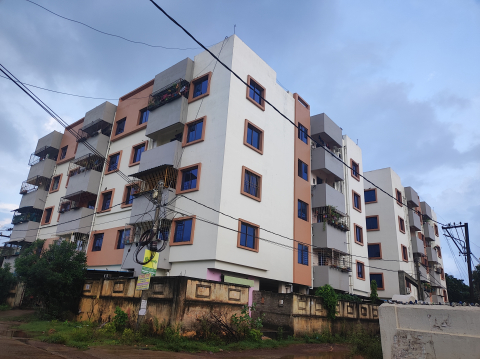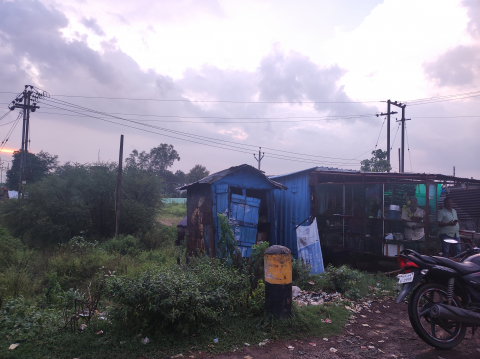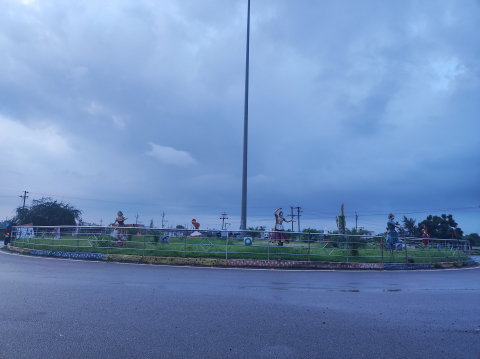Pathway to sustainable, resilient, and inclusive development in Jajpur, Vyasanagar and Panasa G.P in Odisha, India
The impending rise in urbanization rates presents a significant opportunity for the core urban centers in the Jajpur district and Panasa GP to capitalize on the social and economic benefits of regional development. Situated amidst abundant natural assets, Jajpur, Vyasanagar, and Panasa GP possess crucial resources that, if strategically harnessed, can yield a green growth dividend, fostering long-term economic prosperity and ecological sustainability.
Realizing this potential and charting a course for sustainable urbanization with economic prosperity requires the formulation of a spatial strategic plan rooted in evidence and supported by a robust monitoring framework to track the performance of the development trajectory. Recognizing the interconnectedness of development sectors, an integrated and holistic approach is indispensable. Development policies, spatial plans, and strategic initiatives must be underpinned by a low-carbon and climate-resilient strategy, complemented by technological innovations. This combined approach aims to set the region on a transformative path towards sustainable urbanization.
The challenges
The challenges faced in the twin cities of Jajpur-Vyasanagar are multifaceted and demand strategic interventions. Unplanned development has had adverse effects on access to basic infrastructure and services, as well as transportation and mobility. The absence of structured infrastructure networks for water supply, sewerage, and storm drains poses a long-term risk of pollution, contamination of natural resources, seasonal flooding, and environmental damage.
Moreover, being a prominent center of industrial activity in the region, the twin cities grapple with challenges related to over-extraction and competing demands for natural resources. This potential issue adds complexity to the development landscape. Despite the current population growth rate and urbanization levels in the district being below national averages according to the 2011 census, there is a pressing need to anticipate and accommodate a likely high urbanization rate in the near future within the framework of development planning. Addressing these challenges requires a comprehensive and forward-thinking approach to ensure sustainable and resilient urban development.
How to respond to them?
The potential for higher urbanization rate in the near future presents an immense opportunity for core urban centers in the Jajpur district and Panasa GP to benefit from the social and economic growth rendered by regional development. Given its location and natural assets, Jajpur, Vyasanagar and Panasa GP have several key resources which if harnessed and managed strategically, can offer a green growth dividend for long term economic prosperity and ecological sustainability. Some of the key development opportunities are:
- Leaving No One Behind – apply principles of inclusivity in all development policies, plans and projects to improve lives of all residents and communities in the area;
- Green and healthy growth – explore and implement nature-based solutions to urban development, which integrates biodiversity and ecological resources in a sustainable and resilient manner.
- Diversify regional economy - Harness the archaeological and cultural heritage, handicrafts and cottage industry for diversifying local and regional economy and branding the region as an important heritage node. Opportunities to benefit from industrial tourism can also be explored.
- Symbiotic peri-urban development of Panasa GP to provide opportunities for strengthening the local food systems and supply chains, lower the carbon footprint of the area as a whole and maintain the natural resource base and ecosystem services.
To operationalize these opportunities and carve out a path of sustainable urbanization with economic prosperity, the following strategies are recommended:
- Spatial Strategic Plan: Develop a spatial strategic plan for the twin cities and Panasa GP that is evidence-based. This plan should provide a clear roadmap for sustainable development, taking into account the interconnected nature of development sectors.
- Monitoring Framework: Implement a robust monitoring framework to assess the performance of the development trajectory. Regular monitoring will enable timely adjustments and interventions to ensure the effectiveness of the strategies in achieving sustainable outcomes.
- Integrated and Holistic Approach: Adopt an integrated and holistic approach to development. Recognize the interconnectedness of development sectors and ensure that policies, spatial plans, and strategic interventions are cohesive and mutually reinforcing.
- Low-Carbon and Climate-Resilient Approach: Ground development policies and actions in a low-carbon and climate-resilient approach. This includes incorporating sustainable practices and technologies to mitigate environmental impact and enhance resilience to climate change.
The project also seeks to empower local government entities, Urban Local Bodies (ULB), and key stakeholders in sustainable, resilient, and inclusive development practices. The capacity-building component targets city administrators, policy makers, urban practitioners, and decision-makers, addressing their concerns about the resilience and sustainability of cities and regions. Training sessions will offer participants an in-depth understanding of implementation strategies, practical tools, methods, and indicators for monitoring and localizing the Sustainable Development Goals (SDGs). The program emphasizes interactivity, encouraging active participation in idea exchange and shared experiences. Participants will gain insights into governance, planning, implementation, financing, stakeholder involvement, monitoring tools, and policy assessment for achieving sustainable, inclusive, safe, just, and resilient cities.
This project will notably address UN-Habitat's commitments to support the District Collectorate, Jajpur, Government of Odisha in finding sustainable solutions of promoting sustainable urban planning and management in the context of integrating urban infrastructure and service delivery in cities.
What have we achieved so far?
Under the guidance of the District Administration of Jajpur, UN-Habitat has undertaken comprehensive initiatives to address urban challenges and promote sustainable development. The utilization of UN-Habitat’s Urban Sustainability Assessment Framework (USAF) has been instrumental in identifying key diagnostic issues faced by Jajpur, Vyasanagar, and Panasa Gram Panchayat. These issues include:
- Untapped Local Heritage and Livelihood Development Potential: Recognizing the untapped potential in local heritage and livelihoods, strategies have been devised to leverage and integrate these aspects into the urban development plan. This not only preserves cultural richness but also stimulates economic growth at the grassroots level.
- Scattered Urban Growth: The issue of scattered urban growth has been addressed through spatially strategic plans. These plans provide a roadmap for cohesive and organized development, ensuring that growth is directed in a sustainable and purposeful manner.
- Inadequate Road Infrastructure and Absence of Public Transport: Sustainable City Strategies (SCS) include interventions to improve mobility, such as planning Intermediate Para Transit (IPT) movement patterns. Additionally, designing road rights-of-way and intersections reflects a commitment to creating a robust and efficient transport network.
- Fragmented Blue-Green Network: To counteract the fragmented blue-green network, strategies have been developed to connect urban public spaces of varying hierarchies. Integration with tourist hotspots and leveraging blue assets like the Brahmani Riverfront and water bodies enhances ecological resilience and aesthetic appeal.
- Vulnerable Urban Health: Addressing vulnerable urban health, the initiatives prioritize the creation of environments that promote well-being. This involves planning interventions that contribute to a healthier and more liveable urban landscape.
Strategies for Sustainable City Development:
- Low Carbon Footprint Development: Spatially strategic plans focus on developing the cities and peri-urban areas with a low carbon footprint. This includes implementing sustainable practices to minimize environmental impact.
- Preservation of Natural Assets: The strategies aim to safeguard the rich natural assets of the region. This involves a careful balance between urban development and the preservation of the ecological diversity that contributes to the overall quality of life.
- Quality of Life Enhancement: Augmenting the quality of life for communities is a central theme. Through targeted actions and interventions, the initiatives aim to create environments that are conducive to a higher quality of life for residents.
- Harnessing Creative Economy: Recognizing the untapped potential of the creative economy, the strategies incorporate elements that harness and promote local creativity. This includes the promotion of indigenous livelihoods and embedding local crafts in the urban landscape.
Community Engagement and Pilot Initiatives:
- Tactical Placemaking: Schematic designs for the project pipeline will be refined in collaboration with the local community. Tactical placemaking, involving on-ground demonstrations with removable street furniture and placemaking elements, ensures that community input shapes the design strategies.
- Testing and Improvement: Through on-ground demonstrations, designs will be tested and improved with direct community input. This iterative process ensures that the urban assets created genuinely reflect local culture, needs, and preferences.
- Monitoring Impact: The impact of the implementation will be closely monitored through the relevant indicators of the Urban Sustainability Assessment Framework. This allows for ongoing assessments and adjustments to enhance the overall strategy based on real-time feedback.
UN-Habitat's initiatives in Jajpur exemplify a holistic and participatory approach to sustainable urban development. By addressing specific diagnostic issues and incorporating community input, these initiatives aim to create resilient, inclusive, and environmentally sustainable urban environments for the future.
Partners’ Roles and Responsibilities
UN-Habitat India in partnership with the District Collectorate of Jajpur will jointly implement this project. This partnership will explore the technological possibilities and innovations to integrate sustainability strategies into urban planning and management of the project area. This will aim to create a favourable environment for environmentally and financially sound investments in low carbon infrastructure and service delivery, thus building the resilience of Jajpur.






